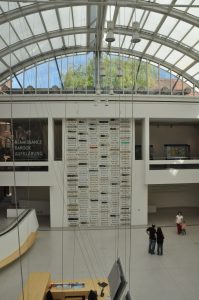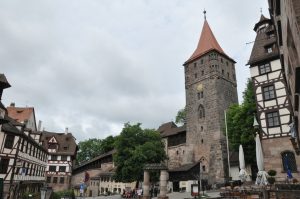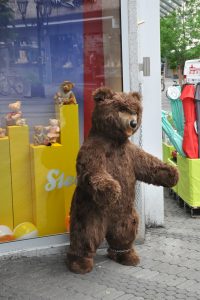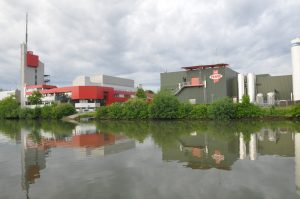We are cruisin’, really bookin’ down the Am Europakanal (aka the Rhine-Main-Danube Canal) toward Regensburg and our hook-up with the Danube. The water rippling by in he damp, gray chill is all I can hear–although a few kilometers back the birds were in forte chorus. A flock of sheep surged onto the shore for a drink, and all else was momentarily baa-baaed over.
I have to stop eating. Breakfast. Lunch. Tea (I mean high tea with sammies and scones and cakes and cream and all manner of calories). Dinner. All of it pretty yummy although my Dear One didn’t think much of the stuffed artichoke hearts. So I ate his.
We made good use of our time in Nuremberg, first day sweltering in 30° C (that’s 86° F) and second day shivering under clouds that weighed temperatures down to 14° C.
I wonder, though, if I should have eked out at least another couple of hours on Sunday in the Germanisches Nationalmuseum. Maybe a peek into the 19th- and 20th-century collections, a quick survey of the folk art. Certainly the Late Medieval collections housed in the former Carthusian church and cloister. But we were both beat, having been up for thirty-six hours or so, feeling grotty after the flight and sweating in the heat.
Albrecht Durer’s house (closed as it was Monday) is certainly the home and studio I would expect of a prosperous professional, Nuremberg’s leading artist of the 1490s and early 1500s. It’s a spacious building that commands a corner just below the castle; this sturdy yet graceful structure with its contrast of dark beams and whitewashed wattle-and-daub must have impressed clients and surely satisfied the owner.
We strolled through the churches of Saints Sebaldus and Lorenz, where photographs illustrated the devastation wreaked by Allied bombs in 1945 in the waning months of the war. We pause on the streets either side of the Pegnitz River to admire the colossal white asparagus and scarlet tomatoes for sale by local farmers. Ironically pollution spewed by aircraft and truck traffic has its beneficial unintended consequences. Glass roofs, like so many transparent umbrellas shielding the fields from noxious spray and dirty rain create pockets of heat that allow earlier planting and faster ripening. A good greenhouse effect.
The bus is due to take us back at 12:15. That leaves us time to watch the Männleinlaufen, the mechanical clock installed in 1506 in the Frauenkirche built a century earlier in the Hauptmarkt, the Main Square. The Holy Roman Emperor, Charles IV, enthroned, is flanked by trumpeters and drummers, who play their instruments as the clock strikes. A procession of red-robed electors appears through a door on the right, circles around and disappears through a door on the left. The crowd, even the fellows erecting a wall of amplifiers for what looks like a rock concert stop, watch, cheer.
The first full day aboard the Viking Alta is also the day of locks. Saturday afternoon, our balcony butted up against a high stone wall. When I rose on Sunday and pulled back the curtain to bring some light onto the writing desk, the view encompassed a Bauhaus-esque assortment of industrial structures. We had begun to move in the dark of night. Then, while we and most of our fellow cruisers were out gallivanting, Captain Igor relocated again.
How many locks are there? Did Mario, our cruise director say twelve? From our point of embarkation in Erlangen, the canal rises 121 meters (almost 397 feet) before descending 67.8 meters (more than 222 feet) to the Danube, bending back and forth in a regular rhythm as it moves us south.
But not right now. We have halted. Must be another lock.





